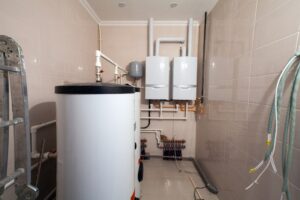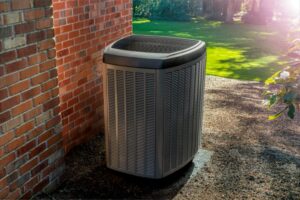Hidden Ductless Mini Split: What You Need to Know
A hidden ductless mini-split offers a modern solution for homeowners seeking the convenience and efficiency of a ductless system with the aesthetic appeal of traditional ducted systems.
By concealing the air handling units within ceiling or wall cavities, these systems provide cooling and heating while maintaining the visual integrity of a space.
As we explore the advantages of these systems, we understand their growing popularity among those who prioritize both design and comfort in their living environments.
Our understanding of HVAC has evolved, and with it, the technology that drives our home climate control.
Ductless mini-splits have gained traction due to their versatility and energy efficiency.
When we choose a hidden ductless mini-split, we opt for a configuration that minimizes visual clutter without sacrificing the personalized climate control that mini-splits are known for.
With tailored installation approaches, these units can seamlessly integrate into the fabric of any home while offering the same benefits as their exposed counterparts.
Maintenance and customization are key components of the hidden ductless mini-split systems.
Though tucked away from view, the accessibility for regular servicing is paramount in their design.
Grille options allow for easy filter cleaning and system checks, ensuring our hidden systems continue to run efficiently and effectively.
As we consider these systems for our homes, we recognize the importance of considering the layout, insulation, and specific climate needs to maximize the potential of our investment.
Understanding Mini-Split Systems
Mini-split systems offer a versatile and energy-efficient solution for both cooling and heating needs.
In this section, we dive into the core components that define these systems, compare ductless and ducted options, and examine the climate control flexibility they provide.
Core Components of Mini Splits
Mini-split systems consist of two main parts: the indoor unit and the outdoor unit.
Together, they form a complete HVAC system without the need for extensive ductwork.
The indoor unit is typically mounted on the wall or ceiling and delivers conditioned air directly into the space, while the outdoor unit houses the compressor and condenser.
The efficiency of a mini-split system is due, in part, to the direct delivery of heating or cooling to specific zones in a home or building.
Ductless Vs. Ducted Mini Splits
We often distinguish mini-splits into two categories: ductless and ducted.
Ductless mini-splits are perhaps the most well-known, offering a straightforward installation process with no need to install ducts.
This not only reduces installation complexities but also minimizes the energy losses often associated with ductwork.
On the other hand, a concealed duct mini-split system uses existing ductwork or newly installed concealed ducts to distribute air.
This type of system is less visible and can provide a more integrated appearance, similar to traditional central HVAC systems.
Climate Control Flexibility
The flexibility of mini-split systems in terms of climate control is notable.
These systems allow for individualized control of different zones within a space—meaning a mini-split can cool one room while heating another.
This zone-specific approach maximizes energy efficiency, as we only heat or cool rooms that are in use.
The advanced technology employed in these systems pairs with thermostats and remote controls for ease of use and precise temperature management, making them a smart choice for varied environmental conditions and user preferences.
Design and Installation Considerations
To optimally integrate a hidden ductless mini split system into our home, we focus on strategic location choice, ensuring proper insulation, and aesthetic harmony.
These considerations are crucial to achieve a balance between design, functionality, and seamless incorporation with our home’s interior design aesthetic.
Choosing the Right Location
For the indoor units, we look for areas that are both functional and inconspicuous.
Placement is typically high on a wall, attic, crawlspace, or basement where it is out of the direct line of sight, thus not becoming the focal point in a room.
We prefer a location that can support the weight and has minimal impact on existing decor. Here is more advice on wall mount mini split units.
Ensuring Proper Insulation
We must ensure the chosen location is well-insulated to prevent energy loss.
This is essential in spaces like the attic or crawlspace, where temperature variations are more pronounced.
Proper insulation maintains the system’s efficiency and performance, which translates to savings on energy bills.
Integration with Home Aesthetics
The system should complement our home’s aesthetics rather than clash with them.
This can involve using a discreet grille that blends with the wall or ceiling, and considering how the unit’s style and cover fit within the overall interior design aesthetic.
For instances where we want to completely hide the unit, we can use custom solutions like building a recess in the wall with a vent that still allows airflow—these innovative approaches are ways to keep the units from being too noticeable. Discover more about maintaining aesthetics with concealed duct mini splits.
Operation and Maintenance
In this section, we dive into the essentials of maintaining a ductless mini-split system, as well as enhancing its performance for greater comfort and efficiency.
We’ll explore the importance of regular maintenance and strategic operation methods that ensure quiet operation and optimal airflow within our spaces.
Routine Mini Split Maintenance
Maintenance is pivotal to the longevity and efficiency of our mini-split system.
To begin with, cleaning or replacing the filter at least once a month prevents dust and debris accumulation, which can impede airflow and degrade indoor air quality.
- Visual Inspection: Routinely check indoor and outdoor units for any signs of wear, damage, or leakage.
- Clean Filters and Units: Regularly clean air filters to maintain air quality and system efficiency.
For a detailed guide on maintaining your system, look at these routine maintenance tips.
Optimizing Airflow and Comfort
Adjusting our mini-split settings helps in comfort control and ensuring quiet operation.
Proper placement of the indoor unit and directional louvers directly influences airflow and, by extension, how our living space feels. We should:
- Adjust the louvers to direct air away from occupants for a gentle circulation.
- Set the temperature to a comfortable level to avoid unnecessary strain on the system.
For specific details on optimizing your system, Alpine Home Air provides an article on hiding ductless mini splits to help maintain aesthetics without compromising airflow and comfort.
Hidden ductless mini split Cost and Energy Considerations
When considering a hidden ductless mini-split system, we must evaluate both the short-term and long-term financial aspects, as well as its energy efficiency.
Our focus is on ensuring that the investment aligns with our heating and cooling needs and our climate, while also offering an efficient solution.
Advantages of Energy-Efficient Systems
Energy-efficient systems, like the hidden ductless mini-split, provide us with significant advantages.
Foremost, they reduce our carbon footprint by utilizing less energy for the same level of comfort.
Systems with high Seasonal Energy Efficiency Ratio (SEER) ratings exemplify this efficiency.
It’s important to note these systems can adapt to various climate demands, providing us with precise climate control for individual zones in the space.
Understanding Cost Implications
The initial cost for a concealed duct mini-split installation may vary extensively, typically ranging from $2,000 to $14,500.
Several factors influence this cost, such as the brand, the number of zones, and additional features like Wi-Fi compatibility or variable speed compressors.
However, despite the upfront investment, we see long-term savings on energy bills due to the system’s efficient operation.
To further understand these costs, let’s reference specific installations such as the costs detailed by Bob Vila.
Additionally, the lifespan and cost to run such systems are critical questions we must address, and resources like HomeGuide’s breakdown can help provide clarity.
Frequently Asked Questions
In this section, we address some of the most common questions regarding the installation, efficiency, maintenance, concealment, advantages, and integration of concealed duct mini split systems.
What are the best practices for installing a concealed duct mini split system?
When installing a concealed duct mini split, we ensure the area of installation can support at least twice the system’s weight.
Correct positioning of the indoor unit promotes efficient air distribution, while selecting an appropriate wall or ceiling space can enhance the system’s performance and aesthetic integration.
How does the efficiency of a hidden ductless mini split compare to other HVAC systems?
A hidden ductless mini split offers high energy efficiency, rivaling traditional central HVAC systems.
We utilize inverter technology which allows these systems to modulate their cooling and heating output based on current room conditions, leading to less energy consumption and more consistent temperatures.
What are the maintenance requirements for a ductless mini split that is hidden from view?
Regular maintenance for a hidden ductless mini split includes cleaning or replacing filters, checking the refrigerant levels, and inspecting the electrical components and condensate lines to ensure optimal operation.
We recommend semi-annual professional check-ups to maintain system longevity.
How can you effectively conceal the vent for a mini-split system in a discreet manner?
To discreetly conceal the vent for a mini-split system, we plan the layout to align with the interior design and structure of the building.
Using custom grille covers or integrating vents into architectural features can help maintain aesthetic appeal.
What are the advantages of using a multi-zone concealed duct mini split system?
A multi-zone concealed duct mini split system provides independent temperature control for different areas, resulting in tailored comfort and improved energy savings.
It’s also scalable, allowing additional zones to be added as needed without major renovations.
Can you integrate a concealed duct mini split with existing home automation systems?
Yes, certain models of concealed duct mini splits are designed with smart features that allow for integration with home automation systems.
This enhances convenience and central control, enabling adjustments of settings through smartphones or other smart devices.
You May Also Like

4 Reasons Your Furnace in White City, OR, Is So Loud
When your furnace in White City, OR, starts making weird sounds, it’s normal to feel anxious, as this signals something is wrong… Continue Reading 4 Reasons Your Furnace in White City, OR, Is So Loud…

Why Does My Heat Pump in White City, OR, Short Cycle?
Barring any extreme temperatures in White City, OR, the typical heating cycle for a heat pump should last 10 to 15 minutes.… Continue Reading Why Does My Heat Pump in White City, OR, Short Cycle?…

4 Signs Your Furnace Is in Need of Repair in Grants Pass, OR
No matter how well you maintain the furnace in your Grants Pass, OR, home, it’ll develop issues at some point because of… Continue Reading 4 Signs Your Furnace Is in Need of Repair in Grants Pass, OR…
